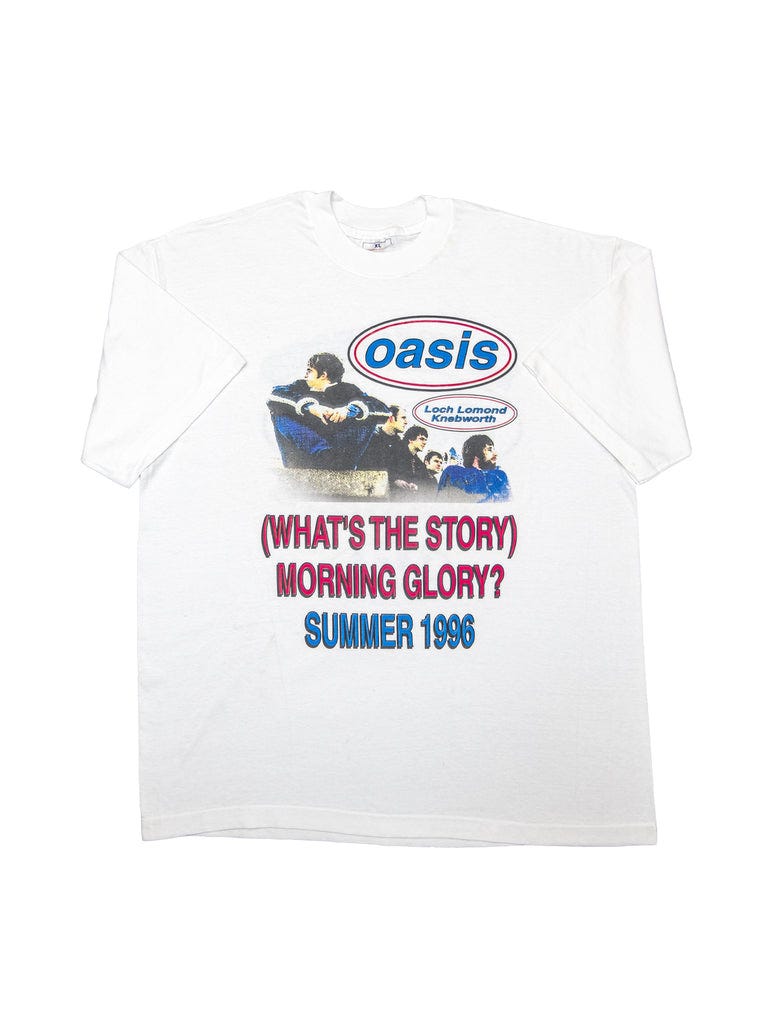Oasis, popularity, quality and taste; Auction Observer 94
Where were you when we were making insulting offers on 1stDibs?
A week ago Oasis reunited, a pleasant and evocative unifying moment in the culture which in a beat put next summer into the forefront as this one winded down. News of the reunion was everywhere… it felt like everyone was queuing up for tickets for their handful of UK shows. I put my both my real and my spam email in for their ballot and didn’t get one sent to either, and after waiting in a digital line with the world for six hours, things didn’t work out, though I am keeping a positive attitude about seeing Oasis in England next summer. The demand on Ticketmaster’s web site was so high that the European Commission’s consumer board is launching an examination into the sale and the band added two extra shows in early fall.
More than that, Oasis was in my blood all week, in my headphones, walking around Paris, where I’m working for the month. Circulating among this pleasant experience was the odd bit of pick-me complaining here and there on socials. The kvetching was less about the mechanics of the reunion than the band itself. Oasis are bad… the reunion we wanted is not the reunion we got. We wanted a Deutsch Amerikanische Freundschaft reunion and we got Oasis; we wanted the Born Innocent lineup of Redd Kross reuniting (strange post since they kind of never broke up), instead we got these two bros from England. I don’t agree but I get the derision. If you don’t like Oasis and have an ear and an eye open, the praise wave I am sure is unendurable. It’s definitely not worth fisking the mechanics of these social media posts—or even weighing in on this particular type of behavior—so I won’t. But the swell of excitement around the reunion and how broad the reaction has been got me thinking about the relationship of popularity and quality, so to speak, and whether these things are connected.
A massive topic that can’t exactly be satisfactorily addressed in a newsletter. But, in brief, as a rule, they are not. Popular things can be anywhere from very well-executed and very well thought out, and transcendent, to complete failures, as can obscure things. Overall what a thing is and how it’s received tends to be an incidental, not primary, relationship. Most days of the year I’m not sure one has to do with the other.
The difference for both music, and, in some ways, design, is that 30 years ago popular things and very good things lined up pretty often. Or often enough, compared to right now. There were so many well-executed, well-considered popular things back then—comparatively—that there was even real variance among these popular items. You couldn’t properly use ‘popular’ as an adjective and be very accurate. But over the past decade it’s changed. If something popular happens to be incredibly executed then it feels like a miracle. (It doesn’t really feel like most things are bad, but rather small, crafted, rushed or very thin.) Oasis, I think, is a miracle of this variance and of this older era. They were, at the time, insanely popular, not the world’s only popular band, but absolutely among them. And throughout they did many things very differently.
Oasis… very palatable, very deep, lots of contradictions, lots of detail… making for a sum greater than its parts, something close to legend, which mostly exists, in music anyways, on a much less popular scale, or underground. I picked up on one of the immediate contradictions rewatching their documentary over the weekend. One would think, just watching popular short clips from their interviews, which were so unaffected and honest and funny, that the art they created would be as ironic and funny and egotistic and charged. But it’s mostly contemplative and prone. Sometimes these things would line up, like in Girl With Dirty Shirt, a love song about a broad knocked up by someone else; or when Noel told Richard Ashcroft, the clearly beloved subject of Cast No Shadow, to “get your shit together,” before introducing the tune at Knebworth:
But mostly they acted apart from their music. The music speaks for itself; but throughout it’s an accumulation of detail… the shit is so good, honestly, I don’t want to break it down. I do think about the “No Slade, No Oasis,” line from Noel Gallagher, with them too often being compared to the Beatles, and how some of the biggest hooks in their discography have centered around words that don’t mean anything. Like “Maybe”—a worthless word—as the singalong in Wonderwall, and WW itself, as a word, not meaning anything until it became a song. (And which now… means everything; it’s also a Japanese interior design firm with some renown for designing stores; mostly Bape, but also Marc Jacobs in Tokyo in 2002, the first Thom Browne flagship in Japan, a 2007 Dean and Deluca (?) in Roppongi… a Fred Perry store in Moscow…) Many bands do this, for sure, but there’s a thoughtfulness here, and real craft…
CORRECTION: Wonderwall was George Harrison’s debut record… from 1968… Snake regrets the error… thank you to reader and friend Gil for the correction
On a design level, the band looked different from most bands that used guitars—except for a handful in Manchester—and were a nice break from rock history and the color black, two great aesthetics to volunteer out of. They didn’t wear skinnies… they didn’t have long hair, but had haircuts… they wore parkas, or Umbro Man City jackets (above), or Aquascutum oxfords, big and untucked. I could spend a newsletter on their logo (it is breathtaking)… which, when wielded through their body of work of T-shirts… is completely peerless. The best Oasis shirts were brutalist, or avant garde, or hideous, or looked like bootlegs.
You have to click through the link here and look at the slides. The car in the pool shirt, the red die, the ‘96 tour shirt (another below), the flag one on the last slide, are up there, without qualification, as among the best-designed pieces of casual clothing of all time. So much of that is because the logo afforded them room to take real chances.
This is a lot of depth and contradiction for an incredibly popular group, and I think this depth explains some of the popularity now. As for whether Oasis are good or not, that’s up to the listener. But formally, including the music, and ignoring it, they’re a masterwork of execution on just about every level, with no deficiencies, or corner cutting. The more and the longer you look at Oasis, the more there is.
This feels unheard of today for popular output, which is not exactly criticism. Some of what popular acts do now can’t be replicated on an Oasis klevel because of structural reasons. There isn’t a monoculture anymore, really, and there especially is not one in music. Some of this is because of the telecommunications act of 1996, which effectively killed local radio and centralized the medium to “basically just Clear Channel affiliates,” says Clayton Blaha, a tech executive and music writer (with a Substack). This brought an end to the era when regional acts, he says, could build up a body of work and a following, and break out through terrestrial radio.
Effectively it is very different now from when Michael Jackson, in the 1980s, was on every single radio station, for hours, all over the world, every day. To be sure, Blaha says there are many more ways to find songs now for most people, and lots of the stuff that is very popular now is coming from avenues that were absolutely not around 30 years ago. “But to be discovered in ‘95,” says Blaha, “there had to be a groundswell of attention behind someone, and they had to have had a local history of playing shows and getting local radio support. Now discovery is organic, but the music it indicates is… hollow and meaningless, with no story behind it. No one cares about anything beyond the hook.” This feels like a failure. Lots of good songs right now, sure, but a band only having good music is def. not enough.
Oasis stuck out from other very popular acts even then. They did so many tiny things right, and so obsessively that it feels like a miracle now that they did it. What stuck out the most to me in the doc was the earnestness with which they comported themselves as musicians. This only snuck through, in spurts, through the drugs and the jeans and the lore. The Gallaghers (and Bonehead) studied bands, imitated their style, read the fine print on tour posters, zigged and zagged, framing their lives, even before the band went anywhere, or before it was a band, around being a band that was good. (Call it creative direction…) Noel was a roadie for the Inspiral Carpets, man… they were obsessed with the Mondays and the Roses and Slade… what came out was its own concoction, stylistically, musically… it’s a rewarding thing… I’m not sure popularity at this level can be explained. What comes out in the doc was Oasis tried, and were talented, and the depth of their interests, the exacting nature of their execution, the universality of what they were about—songs about EMOTION and about life—suited them for this fame, and allowed them to dictate its terms as their popularity grew with them.
So that’s Oasis, and there is a light relationship to design here, which is that sometimes the most universally appreciated and revered and shared things in the culture are better and deeper than advertised, and are as lauded as they are for a reason. But not because they are popular; but because they are good. And, sometimes—actually, pretty often in design—what is massively popular over time, and what is well regarded and fēted is not embedded because of payola or only industry machination but because the item itself is very deep, and it is thoughtful, and works on enough levels, and is a true human expression and palatable enough that other smart people in a functioning industry trying to make a little bit of money on it can help get it/keep it in front of more people.
This, I think, is the back of the envelope explanation for any number of nationally-revered designers whose work, after decades, remains challenging and rewarding. Like Joe Colombo, who was a hero in Italy and who changed things with his work in plastic, or Le Corbusier, whose face is on stamps and who perfected steel, or, in America, Eames or Frank Lloyd Wright who made lasting straightforward furniture. (I’m selling all their legacies short here.)
This is a nice thing to keep in mind if you’re a person at the beginning of your design journey. The very very very very popular stuff is good. It is universal. It is great. Lots of it doesn’t need justification. A chair like the LC2… forget about it. Newer reproductions are not always luxurious quality, but if you’re reading this newsletter, well… there are auctions. And while there is an untold wealth of more obscure items and designers out there, there is so much good stuff on main street.
Music and furniture are very different to be sure. But both can be true. When either is done the right way, and when it meets people on a very high level, and when small details are executed in the service of very big ideas or concepts, or feelings, then there’s a chance it will last—30 years, or three times that.
And while there’s much not to like about design, the best thing about it, by far, is how the most front-facing items are so often its most available ones. We don’t need to pick the most obscure and ignored and underappreciated, undistributed thing out there for it to be good. Elvis is still The King. Know what I mean?
Ending values for last week’s auctions:
Under $300:
Sottsass for Flavia MM porcelain plates unsold, relisted; Bianconi balustrade sold; Colura flatware set (19pc) from 1960 sold (nuts), Haller Kitos table (under $150!); Saarinen/Knoll 72 chairs; Gardella pendant lamp; Rare Weber Grill (probably sold to Bruce Willis); Stam S43 chair (unreal)
Under $600:
PL Powell-style occasional table; flat chandelier ceiling lights; BBPR armchair
Objective deals and fair prices for investment:
Sarfatti 523 lamp $1,600 (value ~$2,200); F. Knoll/Partners desk $1,600; Eames screen $1,600; Grcic Miura stools (6) for $1,000; D’Urbino/Lomazzi Scacciapensieri chairs (Lafer-like) pair sold ~$2K; Sottsass Mandarin chairs (5) unsold, relisted ~$3K
Obs 094
Castiglioni Arco lamp for Flos, Montreal: Ends Tues… A good argument for the popular argument above; a very everpresent lamp a decade ago, but I feel like it is coming back and we have been too harsh on it. It is a bit nasty and the marble and the arc frankly just work. It is wild as Castiglione (prob. the best-dressed architect ever; not a compliment) made the Mezzadro stool (tractor seat) the Stella (bike seat), the Snoopy lamp… I suppose this is just as poppy. part of a beat auction from Canada that does include one perfect chair which is:
The Wink:
By Toshiyuki Kita for a fair price. Amazing color too; weak Canadian dollar, both auctions right now at $600C. The Arco runs about $2,000, the Wink a few hundred less domestically.
Below the wall: three more writeups, 20 more items, all but one under $1,000, including a #snakediscovery (heretofore unwritten-about designer), lamps, chairs, desks, tables, Italian, French, mid-modern, American, avant. Invest in your living space! Support independent journalism! Level up your design cortex! All for less than the price of a bodega sandwich a month.
Keep reading with a 7-day free trial
Subscribe to SNAKE to keep reading this post and get 7 days of free access to the full post archives.









